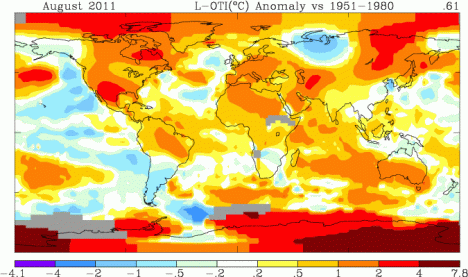‘Missing’ heat found deep in the ocean - New study explains why global surface temperatures don’t rise in a straight line -


Changes in ocean currents and circulation are capturing some of the sun’s incoming heat deep in the ocean, according to researchers with theNational Center for Atmospheric Research, who said their latest computer models account for some of the global warming heat that’s “missing” from land and sea surface temperature readings.
The heat is stored at depths below 1,000 feet and could lead to periods as long as 10 years when the rate of heating on the Earth’s surface flattens. The findings also suggest that several more intervals like this can be expected over the next century, even as the trend toward overall warming continues.
“We will see global warming go through hiatus periods in the future,” said NCAR’s Gerald Meehl, lead author of the study. “However, these periods would likely last only about a decade or so, and warming would then resume. This study illustrates one reason why global temperatures do not simply rise in a straight line.”
The research, by scientists at NCAR and the Bureau of Meteorology in Australia, will be published online on September 18 in Nature Climate Change. Funding for the study came from the National Science Foundation, NCAR’s sponsor, and the Department of Energy.
The 2000s were Earth’s warmest decade in more than a century of weather records. However, the single-year mark for warmest global temperature, which had been set in 1998, remained unmatched until 2010.
Yet emissions of greenhouse gases continued to climb during the 2000s, and satellite measurements showed that the discrepancy between incoming sunshine and outgoing radiation from Earth actually increased. This implied that heat was building up somewhere on Earth, according to a 2010 study published in Science by NCAR researchers Kevin Trenberth and John Fasullo.
The sprinkling of global warming deniers and skeptics in the science community latched on to the concept of “missing heat,” claiming that it somehow showed that the existing global warming models are flawed.
Now, the latest study by the NCAR climate scientists suggests that the oceans might be storing some of the heat that would otherwise go toward other processes, such as warming the atmosphere or land, or melting more ice and snow.
Observations from a global network of buoys showed some warming in the upper ocean, but not enough to account for the global build-up of heat. Although scientists suspected the deep oceans were playing a role, few measurements were available to confirm that hypothesis.
To track where the heat was going, Meehl and colleagues used a powerful software tool known as the Community Climate System Model, which was developed by scientists at NCAR and the Department of Energy with colleagues at other organizations. Using the model’s ability to portray complex interactions between the atmosphere, land, oceans, and sea ice, they performed five simulations of global temperatures.
Read more -

No comments:
Post a Comment